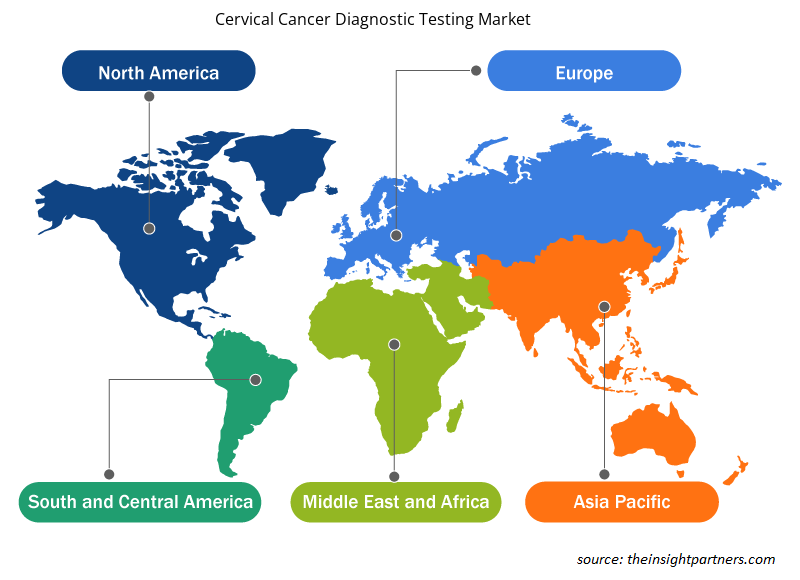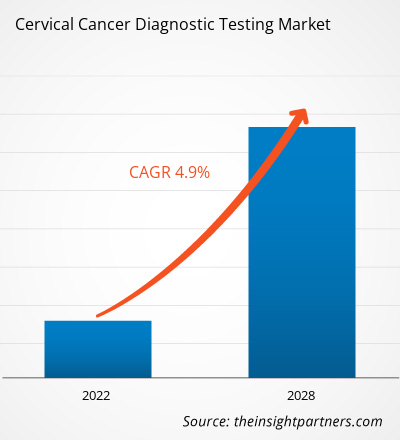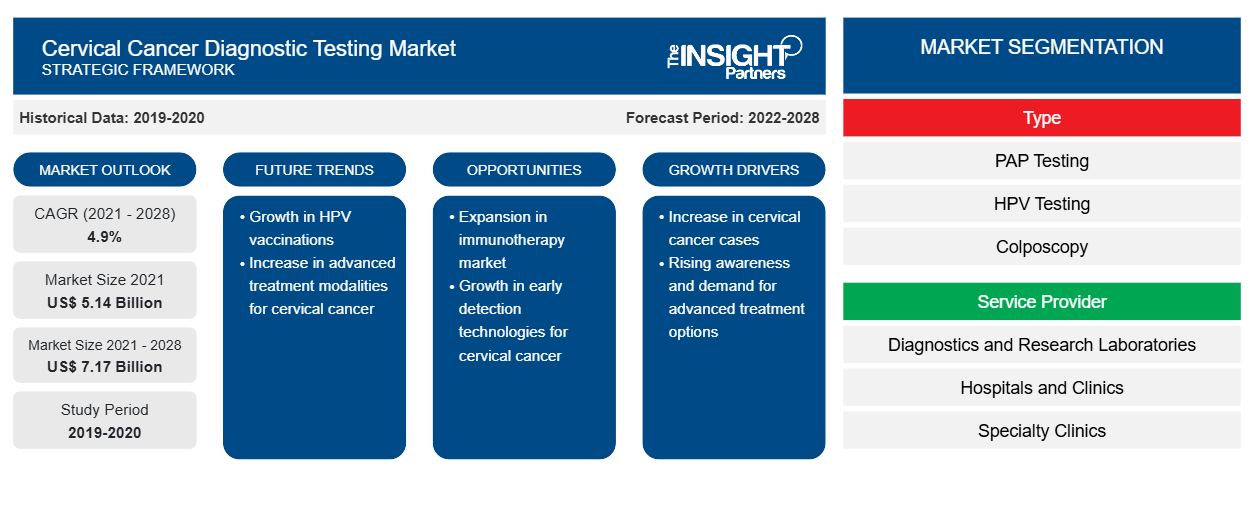Si prevede che il mercato dei test diagnostici per il cancro cervicale raggiungerà i 7.165,92 milioni di dollari entro il 2028, rispetto ai 5.141,25 milioni di dollari del 2021; si prevede una crescita a un CAGR del 4,9% dal 2021 al 2028.
Il cancro cervicale ha un tasso di mortalità significativo (quasi il 50%), che può essere abbassato con la diagnosi precoce e la prevenzione. Le alterazioni precancerose offrono opportunità di prevenzione e trattamento perché la progressione della malattia è spesso ritardata. Tuttavia, a causa della mancanza di consapevolezza o di accesso ai servizi diagnostici, molti casi vengono rilevati in fasi successive della progressione della malattia. Il papillomavirus umano (HPV) è una causa primaria di cancro cervicale che si trasmette tipicamente attraverso i rapporti sessuali. Esistono oltre 100 ceppi di HPV, 13 dei quali sono ad alto rischio o cancerogeni. Il gene attivo, E6 o E7, determina se un ceppo di HPV è ad alto o basso rischio. E6 si lega a p53, causando la distruzione proteolitica. E7, d'altra parte, si lega al retinoblastoma; il legame sposta i fattori di trascrizione precedentemente attaccati, con conseguente arresto del ciclo cellulare e inibizione della regolazione dell'apoptosi. Il test HPV rileva il papillomavirus umano nelle cellule cervicali. Altri approcci di screening impiegati nelle aree a basse risorse dei paesi in via di sviluppo sono il test del DNA dell'HPV e l'ispezione visiva. Lo screening cervicale su base regolare aiuta nella diagnosi precoce del cancro cervicale, abbassando il tasso di mortalità per questa malattia. Ogni tre anni, a tutte le donne di età compresa tra 21 e 65 anni viene consigliato di sottoporsi a un Pap test e alle donne di età compresa tra 30 e 65 anni viene consigliato di sottoporsi sia a un Pap test che a un test dell'HPV. In termini di fatturato, questo tipo ha dominato il mercato dello screening del cancro cervicale nel 2021 e si prevede che continuerà a dominare durante il periodo di previsione.
Personalizza questo report in base alle tue esigenze
Riceverai la personalizzazione gratuita di qualsiasi report, comprese parti di questo report, o analisi a livello nazionale, pacchetto dati Excel, oltre a usufruire di grandi offerte e sconti per start-up e università
- Scopri le principali tendenze di mercato in questo rapporto.Questo campione GRATUITO includerà analisi di dati che spaziano dalle tendenze di mercato alle stime e alle previsioni.
Approfondimenti di mercato
L'aumento della prevalenza del cancro guiderà la crescita del mercato dei test diagnostici per il cancro cervicale durante il periodo di previsione
Il cancro è emerso come una delle principali cause di morte in tutto il mondo. Secondo l'Organizzazione mondiale della sanità (OMS), il cancro è stata la prima causa di morte nelle persone di età inferiore ai 70 anni in 183 paesi e la quarta causa di morte in 123 paesi in tutto il mondo nel 2019. Inoltre, secondo i dati pubblicati dall'OMS a marzo 2021, nel 2020 si sono verificati circa 10 milioni di decessi a causa di diversi tipi di cancro. La crescente incidenza del cancro cervicale tra le donne in tutto il mondo guida la crescita del mercato dei test diagnostici per il cancro cervicale . Secondo l'OMS, ogni anno vengono registrati più di 270.000 decessi di donne a causa del cancro cervicale. I tassi di mortalità per cancro cervicale sono maggiori nei paesi a basso reddito a causa della diagnosi tardiva della malattia. Si prevede che il mercato crescerà nei prossimi anni a causa della crescente accettazione dei test diagnostici per il cancro cervicale per la diagnosi precoce della malattia.
La crescente prevalenza del cancro ha creato un onere per i sistemi sanitari in tutto il mondo. Secondo l'Agenzia Internazionale per la Ricerca sul Cancro (IARC), si stima che il carico globale di nuovi casi di cancro raggiungerà circa 27,5 milioni entro il 2040, e la malattia sarà probabilmente causa di circa 163 milioni di decessi entro quell'anno. Fattori come cambiamenti nello stile di vita, fumo, riduzione dell'attività fisica e condizioni climatiche e di salute incerte porteranno a un carico di cancro ancora maggiore nel mondo negli anni a venire.
Informazioni basate sul tipo
In base al tipo, il mercato dei test diagnostici per il cancro cervicale è segmentato in test PAP, test HPV , colposcopia, biopsie cervicali, cistoscopia e altri. Nel 2021, il segmento dei test PAP ha detenuto la quota maggiore del mercato e si stima che registrerà il CAGR più elevato nel periodo 2021-2028.
Approfondimenti basati sul fornitore di servizi
In base al fornitore di servizi, il mercato è segmentato in laboratori di ricerca, diagnostica e di ricerca, ospedali e cliniche, cliniche specialistiche e servizi di assistenza domiciliare. Nel 2021, il segmento dei laboratori di diagnostica e di ricerca ha detenuto la quota maggiore del mercato e si prevede che registrerà il CAGR più elevato nel mercato durante il 2021-2028.
Le aziende che operano nel mercato dei test diagnostici del cancro cervicale stanno adottando varie strategie come innovazioni di prodotto, per soddisfare le mutevoli esigenze dei clienti in tutto il mondo e mantenere il proprio marchio nel mercato globale.
Mercato dei test diagnostici del cancro cervicale – Segmentazione
Il mercato dei test diagnostici per il cancro cervicale è segmentato in base al tipo e al fornitore di servizi. In base al tipo, il mercato è suddiviso in test PAP, test HPV, colposcopia, biopsie cervicali, cistoscopia e altri. In base al fornitore di servizi, il mercato è ulteriormente suddiviso in laboratori di diagnostica e ricerca, ospedali e cliniche, cliniche specialistiche e servizi di assistenza domiciliare.
In termini geografici, il mercato dei test diagnostici per il cancro cervicale è segmentato in Nord America (Stati Uniti, Canada e Messico), Europa (Francia, Germania, Italia, Regno Unito, Spagna e resto d'Europa), Asia Pacifico (Australia, Cina, India, Giappone, Corea del Sud e resto dell'APAC), Medio Oriente e Africa (Arabia Saudita, Sud Africa, Emirati Arabi Uniti e resto del MEA) e Sud e Centro America (Brasile, Argentina e resto dello SCAM).
Approfondimenti regionali sul mercato dei test diagnostici per il cancro cervicale
Le tendenze regionali e i fattori che influenzano il mercato dei test diagnostici per il cancro cervicale durante il periodo di previsione sono stati ampiamente spiegati dagli analisti di Insight Partners. Questa sezione discute anche i segmenti e la geografia del mercato dei test diagnostici per il cancro cervicale in Nord America, Europa, Asia Pacifico, Medio Oriente e Africa e America centrale e meridionale.

- Ottieni i dati specifici regionali per il mercato dei test diagnostici del cancro cervicale
Ambito del rapporto di mercato sui test diagnostici del cancro cervicale
| Attributo del report | Dettagli |
|---|---|
| Dimensioni del mercato nel 2021 | 5,14 miliardi di dollari USA |
| Dimensioni del mercato entro il 2028 | 7,17 miliardi di dollari USA |
| CAGR globale (2021 - 2028) | 4,9% |
| Dati storici | 2019-2020 |
| Periodo di previsione | 2022-2028 |
| Segmenti coperti | Per tipo
|
| Regioni e Paesi coperti | America del Nord
|
| Leader di mercato e profili aziendali chiave |
|
Densità degli attori del mercato dei test diagnostici per il cancro cervicale: comprendere il suo impatto sulle dinamiche aziendali
Il mercato dei test diagnostici per il cancro cervicale sta crescendo rapidamente, spinto dalla crescente domanda degli utenti finali dovuta a fattori quali l'evoluzione delle preferenze dei consumatori, i progressi tecnologici e una maggiore consapevolezza dei benefici del prodotto. Con l'aumento della domanda, le aziende stanno ampliando le loro offerte, innovando per soddisfare le esigenze dei consumatori e capitalizzando sulle tendenze emergenti, il che alimenta ulteriormente la crescita del mercato.
La densità degli operatori di mercato si riferisce alla distribuzione di aziende o società che operano in un particolare mercato o settore. Indica quanti concorrenti (operatori di mercato) sono presenti in un dato spazio di mercato in relazione alle sue dimensioni o al valore di mercato totale.
Le principali aziende che operano nel mercato dei test diagnostici per il cancro cervicale sono:
- F. HOFFMANN-LA ROCHE LTD.
- Abate
- Diagnostica di ricerca incorporata
- QIAGEN
- Azienda
Disclaimer : le aziende elencate sopra non sono classificate secondo un ordine particolare.

- Ottieni una panoramica dei principali attori del mercato dei test diagnostici del cancro cervicale
Profili aziendali
- Società anonima F. Hoffmann-La Roche Ltd.
- Abate
- Diagnostica di ricerca incorporata
- QIAGEN
- Azienda
- Società farmaceutica DYSIS Inc.
- Società anonima
- Terapie guidate, Inc.
- Società Cooper, Inc.
- BD
- Analisi storica (2 anni), anno base, previsione (7 anni) con CAGR
- Analisi PEST e SWOT
- Valore/volume delle dimensioni del mercato - Globale, Regionale, Nazionale
- Industria e panorama competitivo
- Set di dati Excel
Report recenti
Rapporti correlati
Testimonianze
Motivo dell'acquisto
- Processo decisionale informato
- Comprensione delle dinamiche di mercato
- Analisi competitiva
- Analisi dei clienti
- Previsioni di mercato
- Mitigazione del rischio
- Pianificazione strategica
- Giustificazione degli investimenti
- Identificazione dei mercati emergenti
- Miglioramento delle strategie di marketing
- Aumento dell'efficienza operativa
- Allineamento alle tendenze normative























 Ottieni un campione gratuito per - Mercato dei test diagnostici per il cancro cervicale
Ottieni un campione gratuito per - Mercato dei test diagnostici per il cancro cervicale